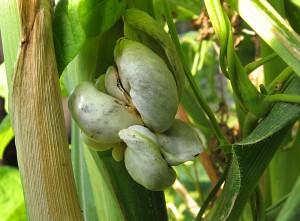And no that doesn’t mean corn pornography*. Corn smut, or Ustilago maydis, is a fungus that infects corn plants. It’s an old acquantance from my days working in the field. We always used to tell the new hires that corn smut was a rare delicacy in some countries (as we’d been told ourselves), but this was in the days before iPhones so until recently I never actually checked on this bit of received wisdom.
Turns out this particular bit of knowledge was true:
The immature galls, gathered two to three weeks after an ear of corn is infected, still retain moisture and, when cooked, have a flavor described as mushroom-like, sweet, savory, woody, and earthy.
I haven’t been able to figure out what the trade off in nutrition is between the ear of corn that is produced by a normal plant and the fungal galls that can be harvested from a plant infected with corn smut. I’d imagine corn smut provides more (and more complete) protein than an ear of corn (assuming corn smut is nutritionally similar to mushrooms.) But what’s the comparison in number of calories? The fungus is certainly sold at a higher price pound for pound.
My renewed interest in corn smut comes courtesy of a new paper** that came out in PLoS Biology describing how the fungus steals energy from infected corn plants without triggering the corn’s usual anti-fungal defenses. It’s an interesting read, you can check out the paper itself since PLoS Biology is open access, or Diane Kelley’s summary at “Science Made Cool.”
I’d seen a number of talks recently about another fungal parasite, powdery mildew in Arabidopsis, but somehow it’s much easier to focus on this stuff now that I can connect it back to corn. Even mammalian systems can be interesting*** once the make that connection.
*Please PLEASE don’t let that phrase start showing up in the search terms people use to find my site!
**Wahl R, Wippel K, Goos S, Kämper J, Sauer N (2010) A Novel High-Affinity Sucrose Transporter Is Required for Virulence of the Plant Pathogen Ustilago maydis. PLoS Biol 8(2): e1000303. doi:10.1371/journal.pbio.1000303
***The talk I’m practicing for Monday actually uses an example of a pheromone receptor in new world monkeys that was lost 23 million years ago in old world monkeys (including us humans).


I never knew that.
When young hard and white all the way through I could consider eating it. Once older though it gets black and mushy, as I am sure you know. Better for pranks/entertainment in the field then eating at that point.
Comment by Greg — February 27, 2010 @ 4:33 pm
Agreed. I could imagine the consistency being mushroom-like when it was young (though I never tried it in all the time since I first heard about it being edible). Older growths… not so much.
Comment by James — February 27, 2010 @ 4:55 pm
Delicious stuff, great in a quesadilla. Also, you’re currently 12th on google for that search term.
Comment by Jeff — February 27, 2010 @ 7:47 pm
I’ll have to make it a point to actually try it sometime. Hearing someone say it’s not only technically edible, but tasty is very reassuring.
Comment by James — February 27, 2010 @ 10:05 pm
You can purchase it canned in many Mexican supermarkets in California. Not nearly as good as the real deal, but not bad if it’s the only option.
Comment by Jeff — February 28, 2010 @ 12:43 pm
My first introduction to that was from Edible Boston, actually. You can see the issue cover here: http://www.ediblecommunities.com/boston/online-magazine/online-magazine.htm You can get to the whole article from that issue, but it’s a pdf and I don’t like to link to those directly.
I’m going to need to go to Tu Y Yo and see if it’s on the menu. It’s just down the street from me.
Comment by Mary — February 28, 2010 @ 11:28 am
I winced at the description of the fungus as a vegetable, but this quote made up for it: “It tastes like kissing somebody, like love.”
If the research described above helps in the development of truly resistant breeds of corn, perhaps there will be less resistance to the intentional cultivation of corn smut/mexican truffles.
Comment by James — February 28, 2010 @ 6:44 pm
“Corn Smut Films” would make a great name for a media company that does agricultural films. It would get a lot of inadvertent hits on google. Might even top PZ Myers’ post on “Tentacle Porn!”
Comment by Karl Haro von Mogel — March 1, 2010 @ 11:00 am
Huitlacoche is delicious. I’ve even seen it said that one reason the mutant teosintes were noticed is that early people were looking for the fungus, not the seeds.
Comment by Jeremy — March 3, 2010 @ 3:51 am